Algal Blooms in Guam
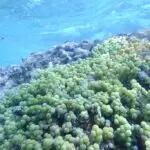
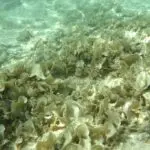
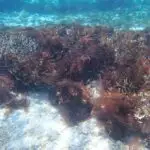
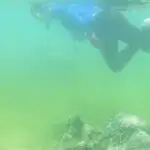
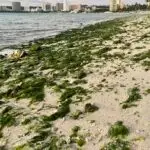
Table of Contents
Share This
Marine algae and natural seasonality
Marine algae, also known as seaweeds, are a diverse group of organisms. Taxonomically, there are 4 main clades: the green algae (Chlorophyta), red algae (Rhodophyta), brown algae (Phaeophyta), and blue-green algae (Cyanobacteria). Functionally, these organisms play many roles in marine ecosystems. For more background information, see “Seaweeds Overview”.
Algae are naturally occurring members of marine environments, with natural fluctuations in light and temperature throughout the year driving seasonal patterns of algal abundance. Like many plants on land, some algae species are “annual,” meaning they experience population fluctuations on a yearly basis and may disappear in some seasons and reappear in others, and some are “perennial,” as they have a constant presence in the ecosystem.
In Guam, annual algae species exhibit seasonal blooms depending on the area of reef that they inhabit. For example, populations of the green alga Caulerpa racemosa, commonly called the “sea grape,” have been documented to peak between December and May. Beginning in May, Guam’s reef flats experience low tides during the hot summer daylight hours. As water temperatures heat up on our shallow reef flats during the day, C. racemosa populations gradually disappear from the reef flats.
Other species are always present on the reef, meaning they are perennial. An example of a perennial group of algae in Guam is Padina (Figure 2). This genus of brown algae inhabits the shallow reef flats of Guam year-round.
Algal blooms and their environmental drivers
Unlike the annual population dynamics that naturally occur in marine ecosystems, an algal bloom is a sudden, unpredictable proliferation of algae in the water. This creates a monoculture environment where one species of algae dominates the entire area. Often, blooms are temporary and last a few weeks. These blooms can be caused by many factors, including increased light availability, a change in water temperature, or an abrupt increase in nutrient input into the water (eutrophication). Nitrogen is an example of a nutrient that influences algal growth. As rain falls and runs over the land, it picks up nutrients from soil and carries it into the sea. This can also occur at river mouths, where runoff is moved from the interior of the island to the ocean. Agricultural practices such as fertilization and ranching contribute to increased nutrients in the ecosystem. Many species of blue-green algae, for example, rapidly increase in abundance after intense rainfall because of the increase of nutrients in the water.
Local impacts of algal blooms
Many algae species have been labeled as “nuisance” species due to their “bloom-and-bust” life cycles of huge overgrowth and subsequent die-off. In Guam, algal blooms can affect environmental health, human activities, and the economy. During a large bloom, some algae species overgrow coral or wash up in huge quantities onto our beaches. Blue-green algae in particular have been documented overgrowing and killing coral in Guam (Figure 3). When corals are covered by algae, they cannot absorb light for photosynthesis and get smothered under accumulated sediment or killed by chemicals released by the algae. Corals can also be physically damaged from the competitive overgrowth of too much algae at one time. Combined with other stressors that corals face under climate change, such as heat stress and ocean acidification, prolonged algal overgrowth can lead to major damage on the reef.
Algal blooms also affect human and economic activity. Extremely thick algal mats can get stuck in boat props and affect fishing activities. Additionally, recreational swimming and beach-going can be affected— no one wants to swim in a cloud of stringy algae! When large quantities of algae wash up on shore, beaches become undesirable places to spend time. Tourism plays a large role in Guam’s economy. Two main draws to the island include our beautiful white sand beaches and scenic coral reefs. When algal blooms begin to affect the industry, efforts must be taken to understand their causes and remove or control the nuisance species when possible.
Case study: Algal blooms in Tumon Bay
Tumon Bay, situated centrally on the western coast of Guam, is an area of particular cultural and economic interest to Guam. The CHamoru/Chamorro people have been living in the area since the Pre-Latte era (starting 3,500-4,000 years ago), with many archeological sites located in the area. Economically, it is a hub for tourism, boasting “Hotel Row” that sits landward to long stretches of beach and fringing coral reefs for tourists to explore.
Tumon Bay has unique hydrology and geology that can support algal blooms in the summer. Freshwater aquifer springs line the coast—swimmers often notice patches of very cold water as they swim in the Bay, which is the seepage of groundwater into the ocean. The groundwater is rich with dissolved nitrogen and phosphorous and contributes nutrients to the seawater in Tumon Bay. And the concentration of hotels and other businesses lining the Bay contribute nutrients to nearshore waters from fertilizers. Finally, run-off from the coastal road that runs along the Bay contributes pollutants as well.
Reddish-brown dinoflagellates (a group of microscopic, unicellular algae) bloom in the waters of Tumon Bay when the tide is very low and traps the algae in the Bay, allowing it to multiply quickly and bloom in the warm, nutrient-rich waters. This creates the well-known summer phenomenon of Red Tides (Figure 4). These dinoflagellate blooms have been described for centuries. While they can occur throughout the year, they often are seen in April, around the anniversary of the death of Padre Diego Luis de San Vitores in 1672. Thus, the red waters have been dubbed the “Blood of San Vitores” in local legend.
Another species of algae also commonly blooms in Tumon Bay. Ulva clathrata (formerly known as Enteromorpha clathrata; Figure 5) is a filamentous green alga that can produce extensive blooms that have been documented in since the 1970s. When conditions are favorable for growth, U. clathrata is an extremely fast-growing species that can clog the waters on the western shore. After heavy rainfall, increased dissolved nitrogen input from the groundwater, combined with a period of calm waters and high temperatures, are the hypothesized drivers of the blooms. It has also been suggested that increased phosphorous input, a common component of fertilizer used to maintain gardens, could influence the levels of U. clathrata growth as well. Runoff from gardens and the streets of Tumon provide another avenue for nutrients to enter the water. Therefore, as humans continue to change their surrounding environment and impact near-shore marine ecosystems, nuisance species such as U. clathrata will continue to bloom and, in turn, impact human activities and ecosystem health in Guam.
For further reading
Burdick, David. “Algae overgrowth.” Guam Reef Life, 2017.
FitzGerald, WJ. “Environmental Parameters Influencing the Growth of Enteromorpha clathrata (Roth) J. Ag. in the Intertidal Zone on Guam.” Botanica Marina 21, no. 4 (1978): 207-220.
Matson, Ernest. A. “Water chemistry and hydrology of the ‘Blood of San Vitores’, a Micronesian red tide.” Micronesica 24, no.1 (1991): 95-108.
Peterson, Russell D. “Effects of Light Intensity on the Morphology and Productivity of Caulerpa racemosa (ForsskaI) J. Agardh.” Micronesica no. 8 (1972): 63-86.
Tsuda, Roy T. “Morphological, zonational, and seasonal studies on two species of Sargassum on the reefs of Guam.” In Proceedings of the 7th International Seaweed Symposium, Vol 7. (1972): 40-44.
–––. “Seasonality in Micronesian seaweed populations and their biogeography as affecting wild crop potential.” In Proceedings of Republic of China–United States Cooperative Science Seminar on “Cultivation and Utilization of Economic Algae”. Edited by R.T. Tsuda & Y.M. Chiang. Mangilao: University of Guam Marine Laboratory, 1982.
–––. Seaweed: Enteromorpha. Guampedia.
–––. Seaweeds Overview. Guampedia.
University of Guam Water and Environmental Research Institute of the Western Pacific. Nutrient status of Tumon Bay in relation to intertidal blooms of the filamentous green alga, Enteromorpha clathrata. By Gary R.W. Denton, Carmen M. Sian-Denton, Lucrina P. Concepcion, and H. Rick Wood. Technical Report No. 110. Mangilao: WERI, 2005.
